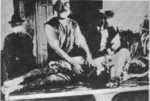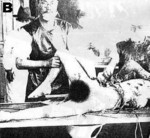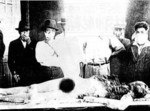Jinan Incident
Contributor: C. Peter Chen
ww2dbaseIn an attempt to unify China by removing local warlords, Nationalist Chinese forces embarked on the Northern Expedition. Han Fuju was the warlord controlling the eastern province of Shandong, and was targeted by the Northern Expedition. As Nationalist troops neared, Japanese troops stationed in the Chinese city of Tianjin, against orders from Tokyo, moved into Jinan and Qingtao in Shandong Province to secure Japanese interests. On 30 Apr 1928, Nationalist Chinese troops entered Jinan, also against Chiang Kaishek's orders, who wanted to avoid a confrontation with the Japanese at this time. Japanese troops and Nationalist Chinese troops remained respectful of each other until 3 May, when a clash took place between soldiers on either side near the home of a Japanese family, resulting in 12 Japanese killed. Tensions mounted very quickly, with sporadic fighting taking place around Jinan. The Nationalist government sent negotiators in attempt to de-escalate the situation, but the Japanese refused to talk, detaining the negotiators. In the evening of 3 May, Japanese troops withdrew out of Jinan, and Chinese troops reported murders and rapes committed by Japanese soldiers against Chinese civilians. The Chinese chief negotiator Cai Gongshi and his team of 10 negotiators were executed around this time; Cai met a particularly gruesome fate as the Japanese cut off his ears, nose, tongue, and gouged out his eyes before executing him. From outside the city, Japanese artillery fired on the Chinese troops who now garrisoned the city, without concern for collateral damage. On 5 May, Chiang Kaishek and local Japanese commander General Hikosuke Fukuda reached an agreement, largely with Chiang conceding to Japanese demands, and the fighting scaled down over the following two days as Chinese troops withdrew. Jinan would become occupied by Japanese forces for the following ten months (Japanese troops departed from Chinese cities in Shandong on 28 Mar 1929), and it served as an excuse for the Japanese to station even more troops in Shandong Province. Chinese sources claimed that 6,123 Chinese military personnel and civilians were killed during the Jinan Incident; a further 1,701 were wounded.
ww2dbaseChiang and Japanese Prime Minister Giichi Tanaka attempted to mend relations between the two countries after the incident; Chiang blamed the incident on the actions of commanding officer He Yaozu of the Nationalist Chinese 3rd Army Group, who ordered his troops to move into Jinan against Chiang's orders.
ww2dbaseSource: Wikipedia.
Last Major Update: Feb 2010
Photographs
 |  |  |  |
Jinan Incident Timeline
| 30 Apr 1928 | Nationalist Chinese troops entered Jinan, Shandong Province, China. Japanese troops had entered that Chinese city without provocation several days prior. |
| 3 May 1928 | Takashi Sakai met with Chiang Kaishek in Shandong Province, China, declaring that the Japanese troops in the Jinan area were tasked only with the protection of Japanese nationals, and promising that they would withdraw from Jinan within days. Chiang was persuaded of Sakai's sincerity. Within hours, however, Japanese troops would attack Chinese troops and civilians in the city. 18 Chinese officials were arrested and executed by the Japanese; Chinese intelligence later determined that Sakai might have personally given the order for the executions. |
| 5 May 1928 | Chinese leader Chiang Kaishek conceded to demands of Japanese General Hikosuke Fukuda in order to de-escalate the violence taking place in Jinan, Shandong Province, China. |
Please consider supporting us on Patreon. Even $1 per month will go a long way! Thank you. Please help us spread the word: Stay updated with WW2DB: |
Visitor Submitted Comments
12 Jan 2015 07:46:46 AM
That photo is "Autopsy of a Japanese victim killed in the Jinan Incident"
It is not Unit 731 photo.
For the long time, it propagated as Unit 731 photo. But, it's wrong.
http://commons.wikimedia.org/wiki/File:Autopsy_of_a_Japanese_victim_killed_in_the_Jinan_Incident.jpg
All visitor submitted comments are opinions of those making the submissions and do not reflect views of WW2DB.

» Sakai, Takashi
» Yamasaki, Yasuyo
Location:
» China
- » 1,182 biographies
- » 337 events
- » 45,132 timeline entries
- » 1,249 ships
- » 350 aircraft models
- » 207 vehicle models
- » 376 weapon models
- » 123 historical documents
- » 261 facilities
- » 470 book reviews
- » 28,430 photos
- » 365 maps
George Patton, 31 May 1944
Please consider supporting us on Patreon. Even $1 a month will go a long way. Thank you!
Or, please support us by purchasing some WW2DB merchandise at TeeSpring, Thank you!
11 Jun 2013 06:49:23 PM
Why is an autopsy even necessary? Why is the surgeon and civilian in protective gear? I notice a uniform guard. The same photo is shown in Unit 731 photos.